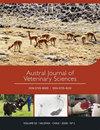一只早熟啮齿动物Octodon degus的剖腹产和卵巢子宫切除术
IF 0.5
4区 农林科学
Q3 VETERINARY SCIENCES
引用次数: 0
摘要
普通的degu(章鱼)是欧洲和美国流行的啮齿动物宠物,但也广泛用于科学研究。在科学文献中有大量关于德狗住房、营养、行为、疾病诊断和疾病治疗的信息。然而,关于生殖管理的信息,如剖宫产、卵巢子宫切除术、卵巢切除术和睾丸切除术,是稀缺和轶事。我们的总体目标是制定剖宫产术和卵巢子宫切除术的方案。我们的研究结果表明,剖宫产术后母亲的生存率为100%,后代的生存率为97%,而卵巢子宫切除术后女性的生存率为100%。剖宫产平均耗时61.82 min,卵巢子宫切除术平均耗时32.65 min。剖宫产和卵巢子宫切除术的初始恢复时间平均分别为8.18 min和5.53 min。剖宫产的完全恢复时间平均为50.18分钟,而卵巢子宫切除术的完全恢复时间平均为15.38分钟。这些结果表明,在使用中级设备的兽医诊所,这两种方案都是可行的。我们讨论了我们的结果与其他啮齿动物和兔子的数据和睾丸切除和卵巢切除手术在德古实践。最后,我们详细讨论了剖宫产和卵巢子宫切除手术在小型哺乳动物,如羚羊进行的四个关键因素。本文章由计算机程序翻译,如有差异,请以英文原文为准。
Caesarean surgery and ovariohysterectomy in a precocial rodent Octodon degus
The common degu (Octodon degus) is a trendy rodent pet in Europe and the USA, but is also widely used in scientific research. Information about degu housing, nutrition, behavior, disease diagnosis, and disease treatment is abundant in scientific literature. However, information on reproductive management, such as cesarean section, ovariohysterectomy, ovariectomy, and orchiectomy, is scarce and anecdotal. Our general objective was to develop a protocol for cesarean section and ovariohysterectomy for degus. Our results indicated that cesarean post-surgical survival was 100% for mothers and 97% for offspring, while ovariohysterectomy female postsurgical survival was 100%. Cesarean surgeries lasted an average of 61.82 min, while ovariohysterectomies lasted an average of 32.65 min. The initial recovery times for cesarean sections and ovariohysterectomies were an average of 8.18 and 5.53 min, respectively. The full recovery time for cesarean section was an average of 50.18 min, whereas that for ovariohysterectomies was an average of 15.38 min. These results suggest that both protocols are viable for use in veterinary clinics that use mid-level equipment. We discuss our results with data from other rodent species and rabbits and with orchiectomy and ovariectomy procedures practiced in degu. Finally, we discuss in detail four critical considerations for cesarean and ovariohysterectomy surgeries performed on small mammals such as degu.
求助全文
通过发布文献求助,成功后即可免费获取论文全文。
去求助
来源期刊

Austral Journal of Veterinary Sciences
Veterinary-General Veterinary
CiteScore
1.60
自引率
0.00%
发文量
18
期刊介绍:
Austral Journal of Veterinary Sciences (formerly Archivos de Medicina Veterinaria) publishes original scientific contributions in English, containing the latest developments and discoveries in veterinary sciences. The journal covers topics such as animal health and production, preventive medicine, zoonosis, pharmacology and therapeutics, methods of diagnosis, and other areas related to the veterinary field.
Austral Journal of Veterinary Sciences aims to divulge information about advances in veterinary medicine among universities, research centres, industries, government agencies, biologists, agronomists and veterinarians.
 求助内容:
求助内容: 应助结果提醒方式:
应助结果提醒方式:


